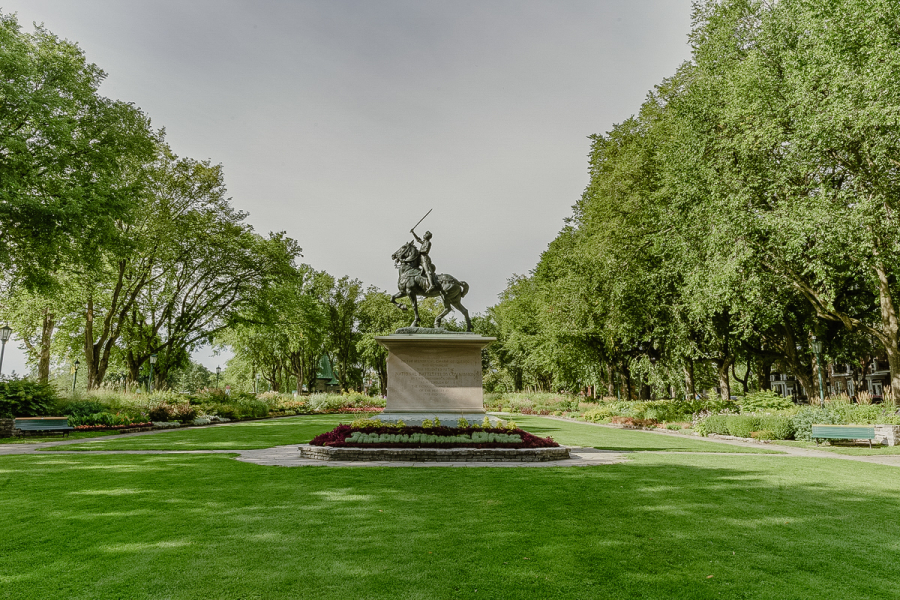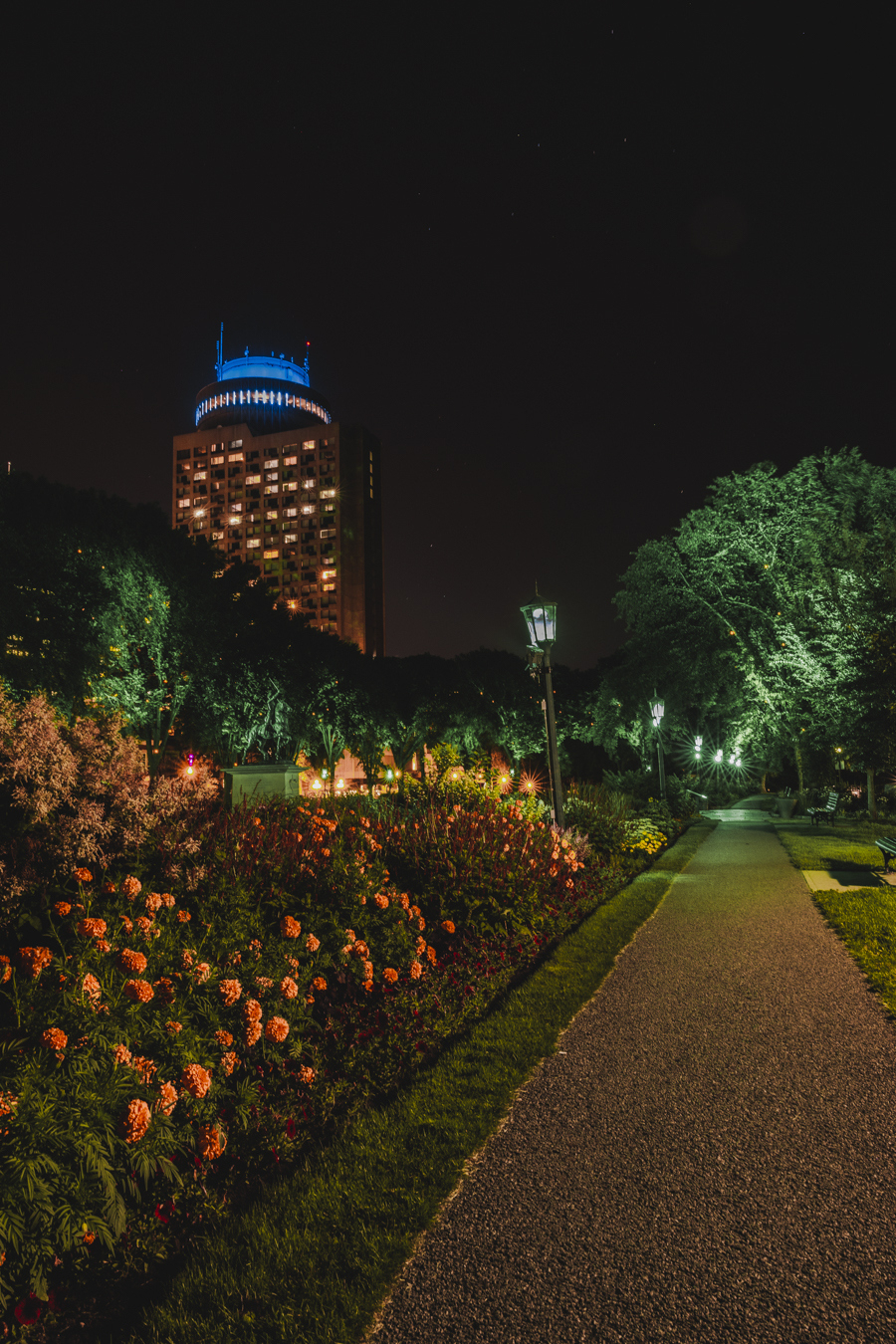New Joan of Arc statue needs a garden
In the 1930s, an American couple donated a statue to the National Battlefields Commission (NBC). This massive artwork depicts a full-armoured Joan of Arc on horseback, her sword raised high. An impressive gift, weighing over 30 tons, the statue and its pedestal, required a suitable site.
The announcement of the gift and the NBC’s intention to create a garden for it was not unanimously welcomed: some felt the piece did not belong on the battle site and were wary of displaying the symbolism of this French heroine in Québec City. A leader in the Hundred Years’ War, Joan of Arc is said to have helped liberate French lands from British rule.
[Note: the initials should be A.-M. for Archer-Miller Huntingdon]
The ideal location for the statue, as well as the justification for accepting such a gift, were topics of hot debate. Discussion was lively even in the Parliament of Canada. Several of its members expressed incomprehension as to why a work depicting a historical figure with no connection to the Plains of Abraham’s past would be installed there. Finally, to calm the ardour of the project’s opponents, the NBC decided to build a garden around the statue a short distance from the Plains of Abraham.
Created just 30 years prior, Battlefields Park commemorates the battles between the French and British and preserves the Plains of Abraham for future generations as a witness to these nations’ shared destiny. In keeping with this mission, it was decided to inscribe the statue’s base with the message: “A tribute to the patriotism and courage of the heroes of 1759–1760. ” It is this patriotism that justified the French heroine’s presence in Québec City’s Battlefields Park. The Garden was inaugurated in September 1938.
Anna Hyatt Huntington
An American sculptor who loved Québec City
The impetus of this garden was the gift of a sculpture from Anna Hyatt Huntington and her husband to the National Battlefields Commission. The American couple fell in love with the city and its heritage charm on their honeymoon, and the statue was a token of this sentiment. Originally, the Huntingtons wished to remain anonymous, but secrecy was short-lived since several 1938 newspapers named the generous donors and shared that Anna Hyatt Huntington herself had sculpted the statue.
Born in Massachusetts in 1876, Anna Hyatt had a remarkable career as an artist at a time when few women were so successful. She specialized in sculptures that included animals, based on careful studying of their anatomy. Her first public work—a statue of Joan of Arc identical to the one on the Plains—was erected in New York in 1915. Other replicas can be found in France, elsewhere in the United States and, of course, Québec City.
She married Archer Milton Huntington in 1923. She continued her art, sharing her studio with several other women artists. Anna Hyatt Huntington was a recognized artist and a member of several art associations, including the National Academy of Design and the National Sculpture Society in the United States. She was also the first woman sculptor to be a member of the American Academy of Arts and Letters.
The garden, as Louis-Joseph Perron imagined it
Tasked with designing the Joan of Arc Garden, Louis-Joseph Perron was the first university-trained French-speaking landscape architect in the province. He was a recent graduate of Cornell University in New York when the NBC commissioned him to design the Joan of Arc Garden. Yet, Perron was no newcomer. Hailing from a horticultural family with a longstanding reputation, Perron already had vast knowledge of plants and landscape design. His father was none other than Wilfrid‑Henri Perron, the owner of W.H. Perron, a seed company that still exists today.
To set the equestrian statue of Joan of Arc on the Plains of Abraham, Perron designed a rectangular garden measuring 165 by 43 metres. In keeping with the goals for Battlefields Park and the justification of the statue’s presence there, the design drew inspiration from both French and British influences: it is a sunken garden with some flowerbeds in the mixed-flower English style and others in the classic French style. American elms line the perimeter of the Garden. Most of the plants are perennials that are grown in the Plains of Abraham greenhouses, in operation since the Park’s inauguration.
Perron’s original plan called for majestic entrances and reflecting pools near the statue. In the end, however, a more modest layout was chosen for financial reasons: the entrances are more modest, and instead of water there are rose gardens. During his prolific career, Perron designed over one thousand landscapes, including the infamous rose and sculpture garden on the Montréal Expo 67 site. As for the Joan of Arc Garden on the Plains of Abraham, Perron truly understood the complexity of the issues at stake and designed a garden that is still the pride of Québec City today.
The Joan of Arc Garden today
For a few years now, visitors have been able to explore the Garden not only when the sun shines, but also at dusk, thanks to a system connected to the Quebec weather station that varies the lighting according to atmospheric conditions. As the year unfolds, custom lighting highlights milestones on the calendar. The nearly century-old elms lining the Garden receive meticulous care to ward off Dutch elm disease, which has wreaked havoc elsewhere on the Plains. Some badly damaged elm trees were felled and replaced by the disease-resistant American elm.
With over 60 different cultivars of annuals, perennials and shrubs, the Joan of Arc Garden has the largest concentration of plant species on the Plains of Abraham. Its landscaping is magnificent in every season. The Plains of Abraham horticultural team transforms it again and again, with the varieties best suited to each season. With thousands of plants supplied by the NBC greenhouses, which are among the oldest still active in the province, horticulturists create mosaicultures all over the Park, notably at the foot of its main monuments, like the Joan of Arc statue.
The Garden is tended with great care and devotion. The statue underwent a meticulous restoration in 2018 with help from the Centre de conservation du Québec. The site welcomes educational activities for school groups throughout the year and is adorned with pieces of Patrick Lavallée’s folk art every October, a tradition started in 2021.
The Joan of Arc Garden continues on as a place of contemplation and wonder for the citizens of Québec City and the many tourists who visit in all seasons.





